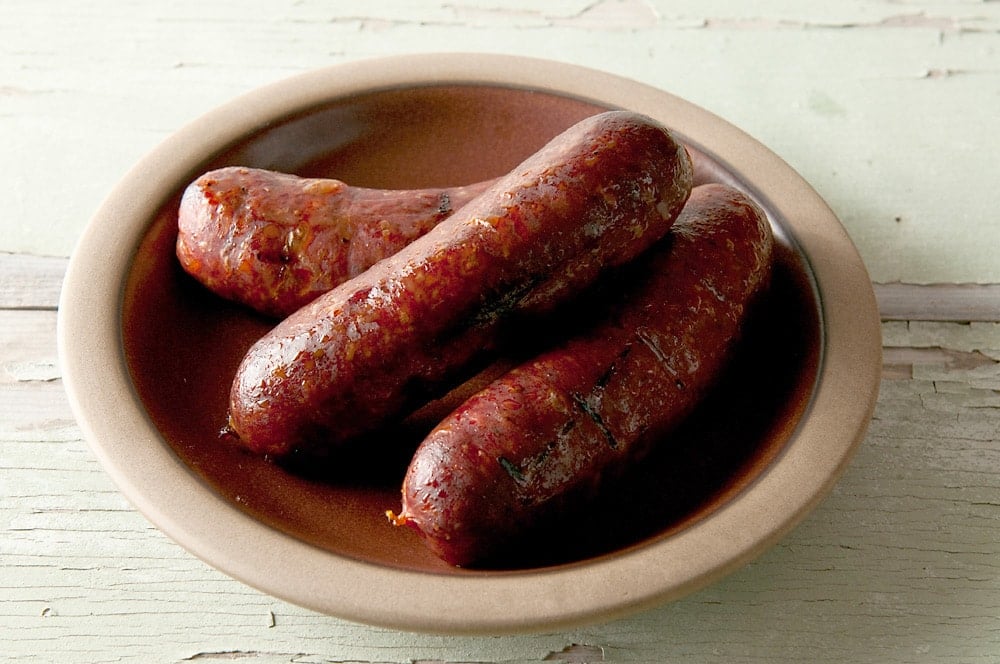Cajun Andouille Sausage
4.8
(18)
Your folders
Your folders
Prep Time: 120 minutes
Cook Time: 180 minutes
Total: 300 minutes
Servings: 20
Author : Hank Shaw

Ingredients
Export 15 ingredients for grocery delivery
Instructions
Step 1
Heat the lard or peanut oil in a small saute pan and cook the onions over medium heat until they are soft, translucent and slightly browned on the edges. Remove from the pan and let cool.
Step 2
While the onions are cooking, take about 10 to 15 feet of casings (typically three lengths) and submerge them in warm water.
Step 3
Make sure you remove as much silverskin as possible from your meat. Cut the meat and fat into 1 to 2 inch chunks and toss with the salt, Instacure, dry milk, garlic, cayenne, paprika, clove, allspice, thyme and powdered mustard. You need the Instacure No. 1 as a safety measure when you smoke the links; if you don't plan on smoking them, you need not use this. You need the dry milk to help the links hold onto their moisture: If you skip this, they will still taste good, but they will shrivel up when you chill them. Put everything in a container and freeze for 30 minutes to 1 hour, or until the mixture is 35°F or colder.
Step 4
Grind the onions, meat and fat through the coarse die. (If you are using the KitchenAid Food Grinder set the mixer on the No. 4 speed) Andouille is most typically a country-style, coarse sausage. If you want, you can even hand-mince the meat yourself. TIP: Hand-mince 1/4 of the meat and fat mixture to get a more interesting texture for your sausage.
Step 5
Make sure the mixture is very cold, about 30°F; you will probably need to freeze it again for a while. When it's cold enough, take it out and add the chilled red wine or beer to the bowl and mix on the lowest setting for 90 seconds to 2 minutes, or with your very clean hands for 2 minutes. This turns what was essentially flavored ground meat into a cohesive sausage. The look of the meat will change as it binds to itself, and will look more like thick batter than ground meat and fat.
Step 6
If you are making patties, you're done. Store each patty between pieces of wax paper and then wrap tightly in plastic wrap, then foil, before freezing. If you are making links, load up a sausage stuffer with the meat and fat. Rinse the casings by running warm water through them: You want to flush some salt and check for any holes in the casings. Thread an entire casing onto the stuffer and fill it slowly. Coil the filled casing as you go. Fill all the casings before making individual links.
Step 7
To make individual links, tie off one end of a casing. Compress the sausage inside it to fill that end link. Pinch off a length of link with one hand, and another link with the other to create a second link next to the end sausage. Flip this second link over to create the sausage. Gently compress the meat in both the end link and this second one. Flip the second link over several times to tighten it. Move down the coil and create two more links. This time, flip the link back toward you to tighten it. Repeat this process down the coil until you get to the end. Tie off the end link. Repeat with all the other casings.
Step 8
Hang your sausages to dry for an hour or more. Hang for 1 to 2 hours at room temperature, or up to overnight where your temperatures are below 45°F. I use a standard clothes drying rack to hang my links. When the sausages are hanging, use a large needle to pierce any spots on the links where there is air trapped underneath. Sterilize the needle in the flames of a gas burner or with a lighter until it glows. You need to pierce any trapped air or your links could burst when you cook them.
Step 9
Once the sausages have hung, smoke them for at least 3 to 4 hours. If you hot-smoke your links, pull them when they reach an internal temperature of 155°F. If your links don't get to that temperature in time, you can either smoke them longer, or you can finish the cooking in an oven set at 200°F. Once they're fully cooked, let them cool before freezing.